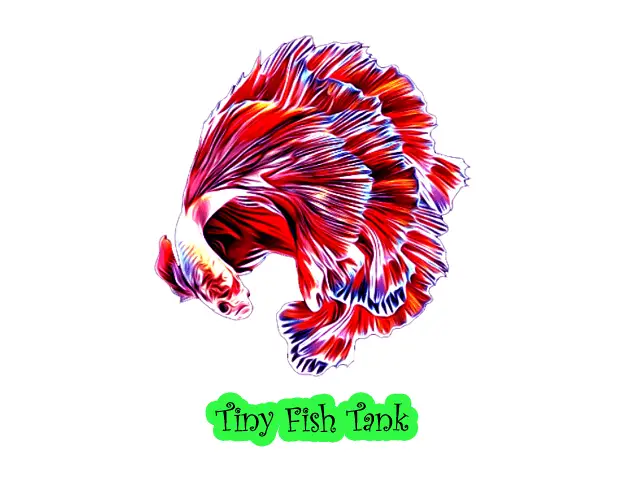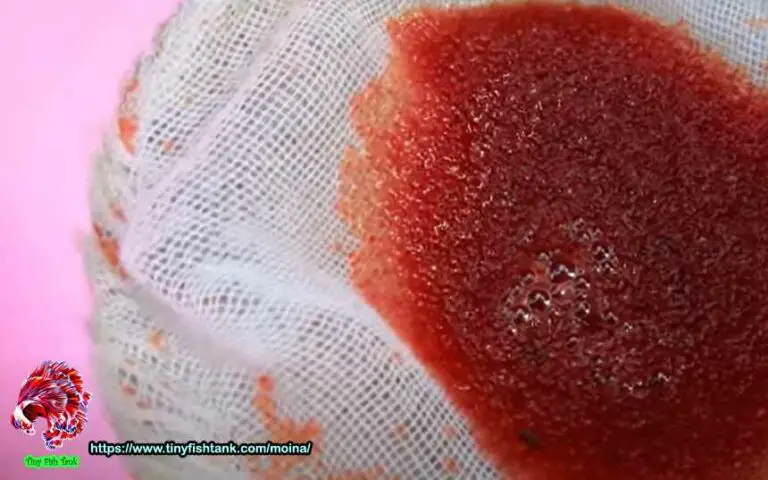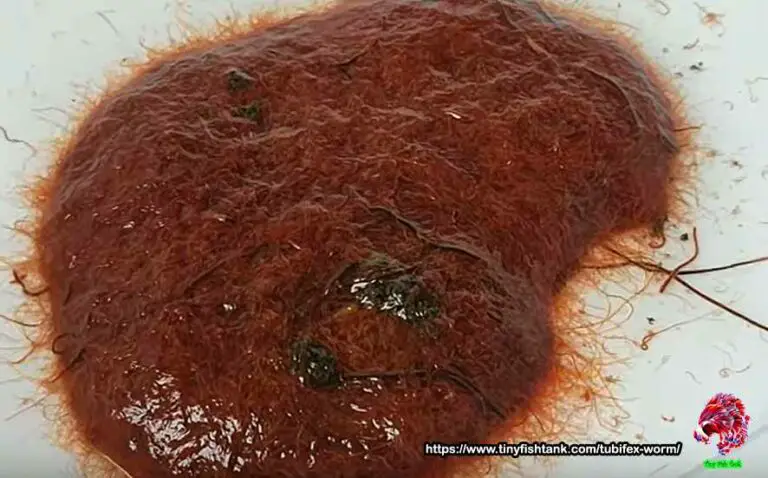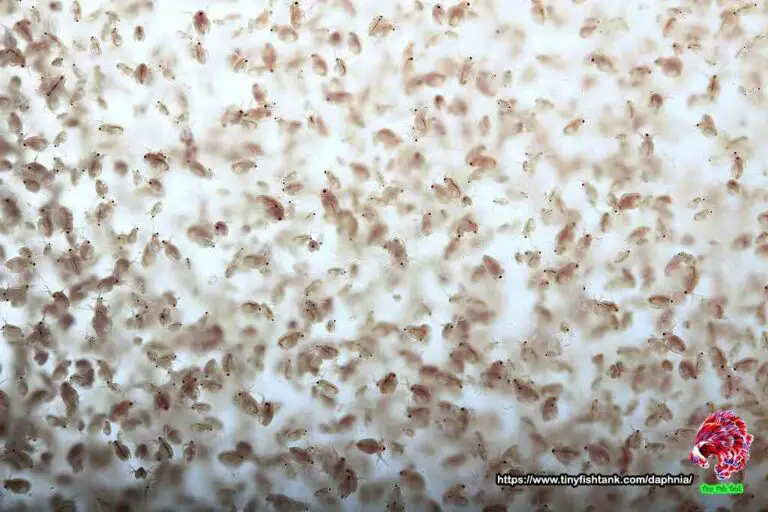Facts Of Bloodworms, Bait, And Live Fish Feed
Bloodworms, known as ‘Glycera dibranchiata‘, are fascinating aquatic creatures belonging to Glyceridae. They are generally found in muddy areas near fresh water.
If you have not seen these worms, bloodworms may appear as red threads wriggling in the water. However, looking closer at them, you can reveal their intricate structure and captivating beauty.
These worms typically grow around 5 – 35 millimeters (around 0.3- 1.7 Inches) in length and have a bright red color that gives them their distinctive name.
One of the most notable features of bloodworms is that they survive in low-oxygen environments. They achieve this through their hemoglobin-rich blood, which allows them to extract oxygen efficiently. This adaptation enables them to live on mud flats and sediments where other organisms struggle to survive.
The bloodworm life cycle is fascinating and marked by specific stages. It begins with hatching eggs, which develop into larvae known as “proboscis worms.” These larvae possess a long, extendable proboscis to capture prey and navigate their surroundings. The proboscis worms undergo metamorphosis as they mature, transforming them into the mesmerizing bloodworms we know.
Bloodworms have a mixed diet, mainly detritus, algae, and small invertebrates. Their feeding habits contribute to the health and balance of the ecosystems they inhabit.
Bloodworms are often used as a nutritional food source for breeding fish, providing essential proteins and nutrients for their growth and well-being.
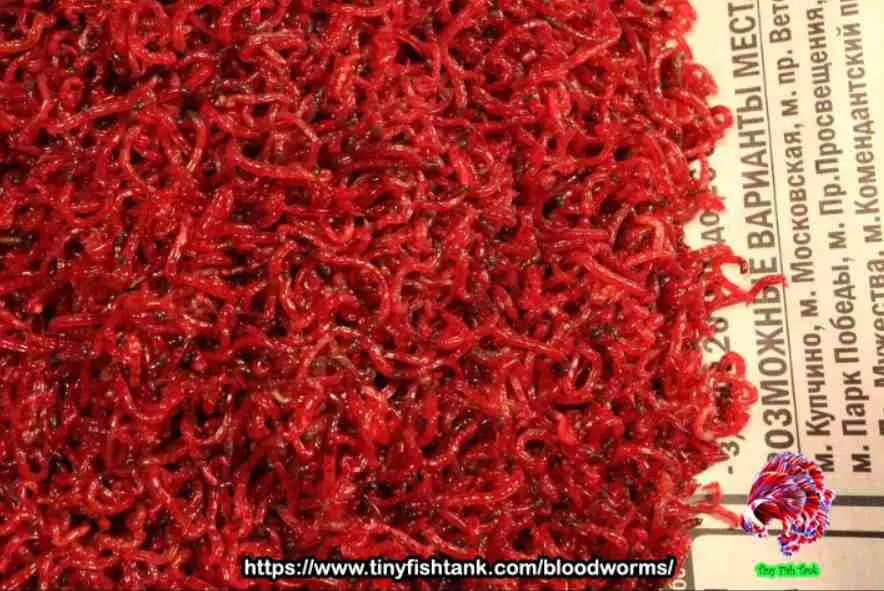
Table of Contents
- The Life Cycle of Bloodworms
- Feed Bloodworms As Nutritional Fish Food
- Cultivating Bloodworms – Tips and Techniques
- Bloodworms types as fish feed available in the market
- Feeding Bloodworms for aquarium fish
- Using Bloodworms as Live Bait: Fishing Secrets
- Bloodworms alternatives
- Frequently asked questions and answers
The Life Cycle of Bloodworms
The life cycle of bloodworms starts with the hatching of their eggs. These bloodworm eggs are usually deposited in the muddy sediments of a lake or canal area, where conditions are favorable for their development. The exact duration of the egg stage varies depending on environmental factors such as temperature, water quality, and water pH level. Generally, it takes around 7 to 14 days for eggs to hatch.
Once the eggs hatch, tiny larvae appear, known as “Proboscis worms .”These larvae have a unique structure called a proboscis, which extends outward from their bodies.
The proboscis serves multiple functions, including capturing prey and aiding in locomotion. It is a wonderful adaptation that allows the larvae to navigate the sediments and find suitable food sources.
When proboscis worms grow, they experience several molts, shedding their outer skins to adjust to their increasing size. The larvae undergo developmental differences during each molt, slowly transforming into mature bloodworms. The molting process is essential to their maturing and development, enabling them to adapt to their changing background.
The duration of the larval stage differs, typically lasting anywhere from a few weeks to several months. Factors such as water temperature and food availability play crucial roles in determining the duration of this stage. The temperature for bloodworms is 72 – 82°F (22 – 28°С). They can live at lower temperatures, but growth is slow.
The pH level is also essential for them, and they can live in the 0 -8.5 pH levels without any problem. The most critical factor is the water flow and current. Bloodworms need slow wave water current water flow and must continue all day. If they want to live without matter, the water should have dissolved oxygen of 3 – 4 mg/L.
Providing sufficient nutrition is essential during this phase, as it directly impacts the larvae’s growth and overall health.
As the larvae mature, they gradually lose their translucent appearance and develop the bright red coloration bloodworms are known for.
This change is due to the accumulation of hemoglobin, a protein responsible for carrying oxygen in their blood. The high concentration of hemoglobin gives bloodworms their vibrant coloring and enhances their capacity to survive in low-oxygen environments.
Once the larvae have finished their growth and development, they enter the final stage of their life cycle. They arise from the sediment and swim freely in the water column, ready to fulfill their ecological roles. At this stage, they are fully qualified to reproduce, continuing the cycle by laying their eggs and starting the process anew.
Things that bloodworms eat in the wild
- Dried wood parts
- Sink Tree leaves
- Small insects live in the mud
- Algae
- Dead water plants
Bloodworm lifespan
Defining a bloodworm’s lifespan is hard because it depends on temperature, water conditions, foods, and pH levels. As well as, bloodworm has several life stages, so no one can define lifespan in that life stages because it depends on the environmental condition.
Feed Bloodworms As Nutritional Fish Food
In this chapter, we delve into the nutritional value of bloodworms and their significance as a food source for fish in the aquarium industry. Bloodworms are an excellent supplementary food for many fish species, including tropical, freshwater, and marine fish.
Bloodworms are highly needed in the aquarium community as nutritional feed for fish. They are rich in proteins, amino acids, lipids, vitamins, and minerals. As a result, they are a complete and balanced diet for a wide range of fish species.
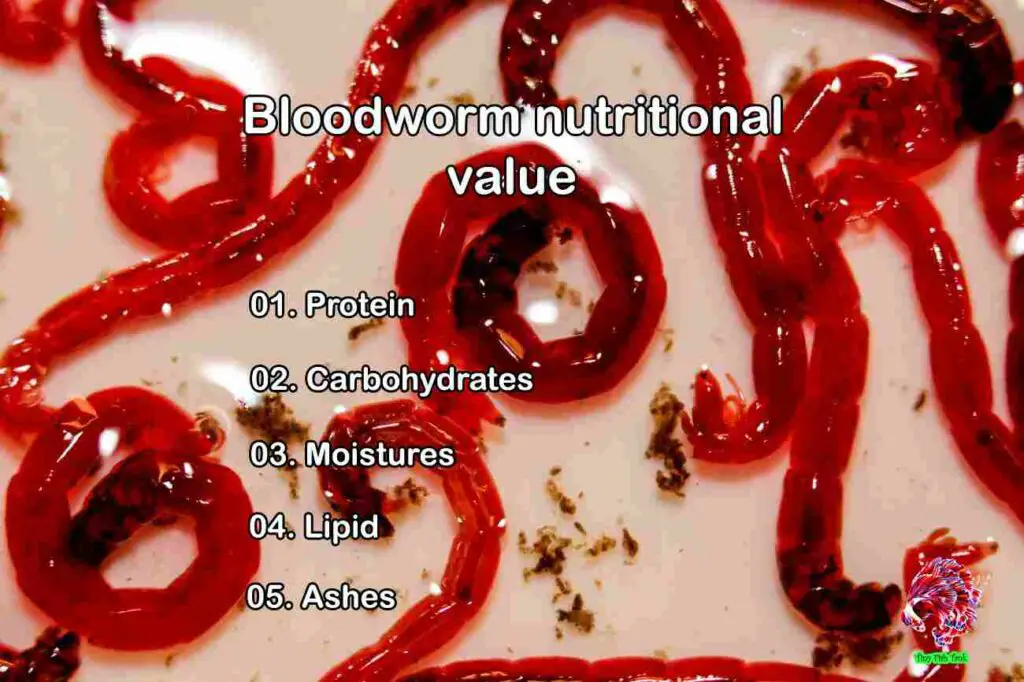
The high protein content of bloodworms helps the growth and development of fish, providing them with the necessary building blocks for healthy muscle and tissue formation.
Proteins are essential for fish as they play a critical role in various physiological functions, including enzyme production, immune system support, and energy metabolism.
Bloodworms offer a readily available source of 59.3 % protein, ensuring fish receive the amino acids to thrive.
Furthermore, bloodworms are an excellent source of 7.22 % lipids, or fats, essential for fish growth. Lipids provide energy, aid in nutrient absorption, and contribute to the structural integrity of cell membranes.
Vitamins and minerals are also included in bloodworms. These micronutrients are crucial for fish health and contribute to various physiological processes. Bloodworms contain essential vitamins such as vitamin C, vitamin B12, and vitamin A, which support immune function, metabolism, and growth.
In terms of minerals, bloodworms are particularly rich in iron, calcium, and phosphorus, which are necessary for bone development, muscle function, and overall mineral balance in fish.
The biggest advantage of using bloodworms as fish food is their high palatability. Fish are naturally attracted to the scent and taste of bloodworms, making them a tasty meal option.
This makes attracting picky eaters or newly introduced fish easier to consume a well-rounded diet.
Bloodworms are highly beneficial but should be part of a varied diet that includes other food sources to ensure a balanced nutrient intake.
Bloodworm nutritional value table
| Protein | 59.3 % |
| Carbohydrates | 20.2% |
| Moistures | 7.34 % |
| Lipid | 7.22 % |
| Ashes | 5.91 % |
Apart from nutritional value, bloodworms also provide the opportunity for natural feeding behaviors. Many fish species indicate predatory behaviors in the wild. Offering live or frozen bloodworms can simulate these natural feeding instincts, providing mental motivation and promoting overall well-being.
Cultivating Bloodworms – Tips and Techniques
Cultivating bloodworms and providing it to fish keepers is not easy. But cultivating bloodworms can be rewarding, offering a sustainable and cost-effective means of providing these nutritious creatures for your aquarium fish.
1. Understanding the Bloodworms Habitat Requirements:
To successfully cultivate bloodworms, arranging their natural habitat conditions as closely as possible is essential. Bloodworms thrive on mud flats or sediments with low oxygen levels. You can create similar conditions by using a container filled with a mixture of muddy sand and silt. You should maintain a moist substrate and ensure proper aeration to provide oxygenation for their survival.
2. Setting up the Cultivation Container:
You can select a suitable container for cultivating bloodworms, such as a shallow tray or a plastic tub. The size of the container depends on the quantity of bloodworms you wish to cultivate. Ensure the container has no holes to leak water and arrange proper substrate moisture levels.
3. Introducing Bloodworm Eggs:
Getting bloodworm eggs can be difficult, as they are typically collected from natural habitats. However, some specialized suppliers may offer bloodworm eggs for cultivation purposes. Once you have received the eggs, gently spread them across the substrate in the cultivation container. Avoid overcrowding, as it can disturb their growth and development.
4. Maintaining Optimal Conditions:
To ensure successful bloodworm cultivation, it is essential to maintain optimal conditions within the cultivation container. Keep the substrate consistently moist, avoiding excessive dryness or saturation. Regularly monitor oxygen levels and provide adequate aeration using an air pump or air stone. Maintain a temperature range suitable for bloodworm development, typically between 72 – 82°F (22 – 28°С).
5. Feeding the Bloodworm Larvae:
Bloodworm larvae feed on detritus, microorganisms, and algae in the substrate. However, providing supplemental food sources can enhance their growth and nutritional value. You can offer microalgae, finely ground fish food, or specialized bloodworm larvae diets available on the market. Ensure the food is finely spread and distributed evenly throughout the cultivation container.
6. Harvesting the Bloodworms:
Bloodworms can be harvested once they reach the desired size, typically around 2 to 4 centimeters in length. To collect them, gently siphon the substrate using a small tube, careful not to disturb the larvae or suck up excess debris. Collect the harvested bloodworms in a separate container for immediate use or storage.
If you have harvested more bloodworms than needed, you can store them for future use. You can rinse the bloodworms using clean water to remove debris or substrate particles. Please place them in a container with clean, dechlorinated water and keep them refrigerated.
Bloodworms can be fed to fish directly, live or frozen. If using frozen bloodworms, thaw them before feeding and ensure they are consumed within a reasonable time frame to maintain their nutritional value.
Following these cultivation techniques, fish keepers can ensure a steady supply of bloodworms for their aquarium fish. Cultivating bloodworms provides a sustainable food source and offers a fascinating and rewarding experience as you notice the transformation of eggs into thriving larvae.
Bloodworms types as fish feed available in the market
- Live bloodworms
Live bloodworms mean you can get bloodworms alive in the market. You can see they are alive in the water and snaking in the container.
- Freeze bloodworms
Freeze bloodworms mean blood worms are not alive and already dead. Now you can keep these frozen bloodworms in the freezer without any problem. Usually, frozen blood worms can find as cubes, so you can quickly feed one cube into the aquarium when you want.
- Dried bloodworms
Dried bloodworms mean they are already well-dried and packed in a sealed container. These dried bloodworms do not contain water; you do not need to keep them in the freezer. Just close the lid of the bottle properly and keep it room temperate.
Now you can find dried bloodworm pallets in several sizes. Generally available sizes are 8mm and 6mm.
Feeding Bloodworms for aquarium fish
You can mainly feed bloodworms for any type of omnivores and carnivores types of fish breed. They like to eat live fish feed than fish pallets. Here is a small list of fish that like to eat bloodworms.
- Betta fish
- Goldfish
- Discus Fish
- Koi fish
- Cichlids fish
- Guppies Fish
- Flowerhorn Fish
- Tetra fish
- Plecos Fish
- Corydoras Fish
- Angle Fish
- Molly Fish
Do not overfeed bloodworms to your fish. You can feed bloodworms to your fish tank twice a week, and sink worms will live a few days. So don’t feed worms daily to your fish.
Using Bloodworms as Live Bait: Fishing Secrets
Bloodworms are used as live bait in fishing. Anglers have long recognized the effectiveness of these creatures in enticing various fish species.
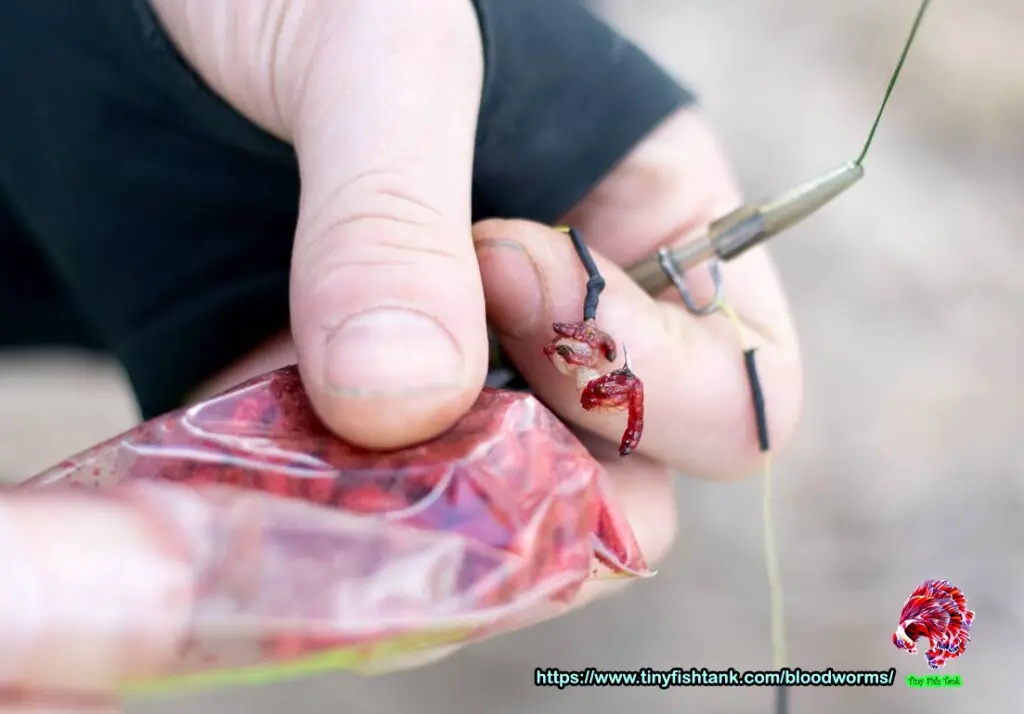
1. Natural Attraction:
Bloodworms contain a natural scent and movement that attracts a wide range of fish species. Their bright red color and snaking motion in the water mimic live prey, triggering fish’s predatory instincts. This natural attraction makes bloodworms highly effective at enticing fish to bite.
2. Versatility and Availability:
Bloodworms are versatile bait options, appealing to freshwater and saltwater fish. They are particularly popular for targeting species such as trout, perch, catfish, bass, redfish, flounder, and many others. Bloodworms are readily available in bait shops, making them easily accessible for anglers seeking to maximize their chances of a successful fishing trip.
3. Natural Presentation:
Bloodworms offer a realistic and natural presentation in the water when used as live bait. Instead of artificial lures, bloodworms have a realistic texture, scent, and movement that closely resemble the prey fish encounter in their natural habitat. This authenticity increases the probability of attracting fish and attracting them to strike.
4. Versatile Fishing Techniques:
Bloodworms can be employed with various fishing techniques, including bottom fishing, floating fishing, and even fly fishing in specific cases. Their versatility allows anglers to adapt their approach based on the target species, fishing location, and prevailing conditions. Bloodworms offer a reliable and versatile option when fishing in freshwater ponds, rivers, or saltwater flats.
5. Longevity and Durability:
Bloodworms have a relatively long lifespan compared to other live baits, allowing anglers to fish with them for extended periods. Bloodworms can remain alive and viable for several days with proper care and storage. Their water durability ensures they remain effective at attracting fish throughout the fishing session.
Bloodworms Fishing Secrets
Experienced anglers often have their preferred methods and secrets when using bloodworms as live bait. From adjusting rigging and presentation to selecting the appropriate hook size and using scent attractants, anglers continually refine their techniques to maximize their success with bloodworms.
Sharing these secrets and techniques within the angling community encourages friendship and continuous learning.
Whether hunting trophy fish or enjoying a relaxing day on the water, bloodworms as live bait offer an effective and time-tested approach for anglers. Their natural attractiveness, bright color, and versatility make them a go-to option for attracting a wide range of fish species.
Bloodworms alternatives
There are a few alternatives that you can use instead of bloodworms. But nutritional value may be different than bloodworms. The price will be same range, and you can quickly feed into the fish.
01. Tubifex worm
02. Moina
03. Vinegar Eel
04. Daphnia
05. Black worms
06. White worms
Frequently asked questions and answers
Do bloodworms bite?
Generally, bloodworms are not bite and do not harm humans. However, if you have any symptoms or concerns after dealing with bloodworm and suspecting a bloodworm bite, it is better to visit the doctor for medical advice.
Why are bloodworms expensive?
Culturing bloodworm is challenging, and it is a costly task. Bloodworm culturing farmers spend a valuable amount of time on this task. That is why you cannot find bloodworms at cheap prices in the market.
Where to buy bloodworms near me?
You can visit your nearest pet shop aquarium house and ask them about bloodworms. Generally, pet shops sell bloodworms, and some pet shops may not sell them, but you can visit an online shopping site and buy dried bloodworms instead of frozen bloodworms. If you live in the USA, UK, Canada, Australia, or New Zealand, you can find and buy quickly via eBay’s online shopping site.
Will chlorine kill bloodworms?
Yes. Chlorine can kill your bloodworms, so don’t provide Chlorine water. Use aged water always if you have a bloodworm culture at your home.
Are bloodworms good for saltwater fish?
Yes. You can feed bloodworms to saltwater fish without any problem.
Are bloodworms and red worms the same?
No. The Bloodworms are different from the “Red worms.” Red worms are not living in the water and mainly living in the wet soil area. Red worms rarely live in muddy areas but not living in deep freshwater areas.
